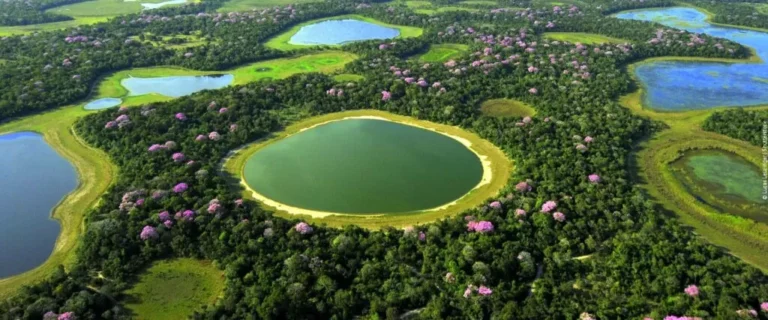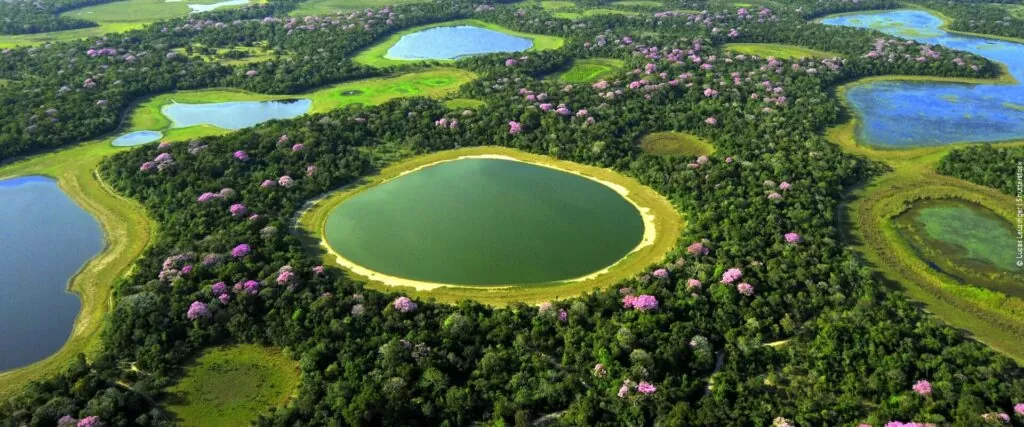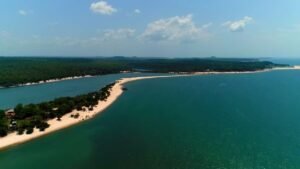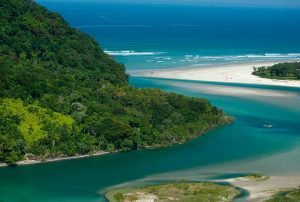The Pantanal, considered the pulsating heart of South America, is one of the most fascinating and diverse ecosystems in the world. Located in the heart of the South American continent, this vast area of floodplain is home to an unparalleled wealth of flora, fauna, and stunning landscapes. For those eager to uncover the secrets of this unique biome, we present 24 facts that will make you fall even more in love with the Pantanal.
Exploring the 24 Curiosities about the Pantanal

1. Water Kingdom
The Pantanal is often called the “kingdom of waters,” due to its impressive expanse of freshwater reservoirs and its vital importance for the ecological balance of the region.
2. Largest Continental Wetland
With an area of approximately 210,000 square kilometers, the Pantanal is the largest continental wetland on the planet, stretching across the Brazilian states of Mato Grosso and Mato Grosso do Sul, as well as parts of Bolivia and Paraguay.
3. Flora Biodiversity
The biome hosts an incredible diversity of flora, with over 2,000 catalogued plant species, including shrubs, trees, and aquatic plants, featuring species such as the midnight water hyacinth and the giant water lily.
4. Interconnection with Other Biomes
The Brazilian Pantanal is directly influenced by three distinct biomes: the Cerrado, Amazon, and Atlantic Forest, resulting in a rich diversity of plant and animal species.
5. Rich Fauna
With an exuberant fauna, the Pantanal is home to approximately 132 species of mammals, 85 species of reptiles, 463 species of birds, 35 species of amphibians, and 263 species of fish, making it a paradise for wildlife observers.
6. Tropical Climate
The predominant climate in the Pantanal is tropical, with two well-defined seasons: winter, from April to September, characterized by drought and high temperatures, and summer, from October to March, with regular rainfall and high temperatures.
7. Plain Relief
The Pantanal is located in a plains area, with average altitudes around 120 meters, presenting regular relief and various flooding areas during the rainy season.
8. Abundant Hydrography
With a vast hydrographic network, the Pantanal receives contributions from several rivers, such as the Paraguay, Cuiabá, Taquari, Piquiri, and São Lourenço, which feed its flood basins and contribute to its biodiversity.
9. Challenges of Environmental Degradation
In recent years, the Pantanal has faced significant challenges due to the advancement of the agricultural and livestock frontier, resulting in negative environmental impacts, such as wildfires and loss of biodiversity.
10. Economic Importance
The Pantanal region plays a crucial role in the local economy, with activities such as livestock, extraction, and tourism, which generate jobs and boost regional development.
11. Symbols of the Pantanal
The Jabiru, the symbol bird of the Pantanal, and the Jaú, a fish characteristic of the region, are examples of the rich Pantanal fauna, which enchants and fascinates visitors from all over the world.
12. Diversified Microregions
Although it is a unique biome, the Pantanal is subdivided into 11 microregions, each with its own characteristics of fauna and flora, providing a unique experience for visitors.
13. International Recognition
Due to its environmental importance, the Pantanal was declared a National Heritage by the Constitution of 1988, and a World Heritage Site and Biosphere Reserve by UNESCO in 2000, highlighting its global relevance.
14. Impressive Dimensions
The 210,000 square kilometers of the Pantanal are equivalent to the combined areas of four European countries—Belgium, Switzerland, Portugal, and the Netherlands—illustrating the vastness and grandeur of this biome.
15. Annual Transformation by River Flooding
The annual flooding of the rivers in the Pantanal, which affects about 80% of the region, transforms the landscape into a unique spectacle, temporarily displacing part of the rural population and attracting tourists in search of authentic experiences.
16. Traditional Means of Transportation
The chalana, a typical vessel of the region, is the official means of transport for the Pantaneiros and one of the most sought-after attractions by visitors, providing memorable journeys along the Pantanal rivers.
17. Cultural Heritage of Native Peoples
With a rich cultural history, the Pantanal was inhabited by indigenous peoples, quilombolas, and descendants of immigrants, who contributed to the formation of the unique identity of this region.
18. Population and Borders
With an estimated population of 3 million inhabitants, the Pantanal spans several municipalities in the states of Mato Grosso and Mato Grosso do Sul, and borders Bolivia and Paraguay.
19. Refuge for Endangered Species
The Pantanal is an important refuge for endangered species, such as the jaguar and the hyacinth macaw, whose preservation is crucial for the maintenance of regional biodiversity.
20. Gastronomy and Music
The Pantanal cuisine, with typical dishes like arroz carreteiro, reflects the simplicity and flavors of the region, while traditional music, such as viola music, delights visitors with its authenticity.
21. Origin of the Name
The name “Pantanal” originates from the word “pântano,” which describes a flooded plain area, revealing the essence of this unique biome.
22. Pantanal Day
In honor of the environmentalist Francisco Anselmo de Barros, Pantanal Day is celebrated on November 12, recognizing the importance of this ecosystem for Brazil and the world.
23. High Season and Special Attractions
The high season in the Pantanal, from June to September, is the ideal time to enjoy the natural beauties and engage in activities such as sport fishing, which attracts enthusiasts from all over the world.
24. Scientific Discoveries
The Pantanal continues to amaze with scientific discoveries, such as the identification of the great ghost bat, the largest bat in the Americas, which can reach a wingspan of 1 meter, highlighting the importance of conserving this unique ecosystem.
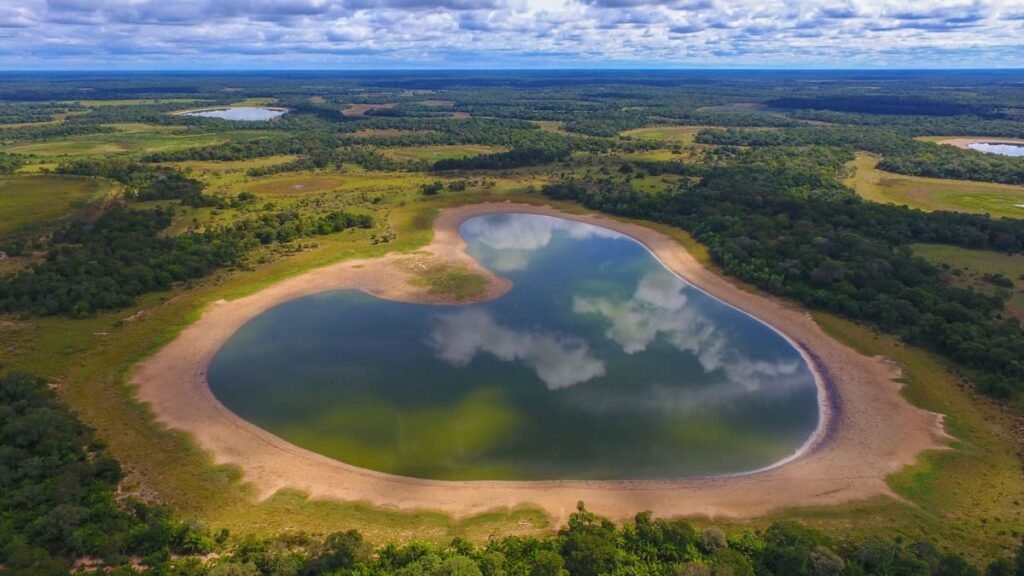
Conclusion
Given the 24 fascinating facts about the Pantanal, it becomes evident that this biome is a treasure of nature, full of biodiversity and stunning landscapes. It is crucial to recognize the importance of protecting and preserving the Pantanal for future generations, ensuring that its natural wonders can be appreciated for many years to come.
Furthermore, it is essential to emphasize the need to promote ecotourism and sustainability in the Pantanal region. Developing responsible tourism practices that respect local ecosystems and promote environmental conservation is vital to ensure that tourism benefits local communities without harming the environment.
Investing in environmental education initiatives, conservation of natural resources, and support for local communities is essential to ensure the long-term sustainability of the Pantanal. By working together to protect this natural treasure, we can ensure that the Pantanal remains one of the most precious and fascinating biomes on our planet, providing benefits both for nature and for the people who depend on it.
Also, explore the curiosities of other biomes present in Brazil:

